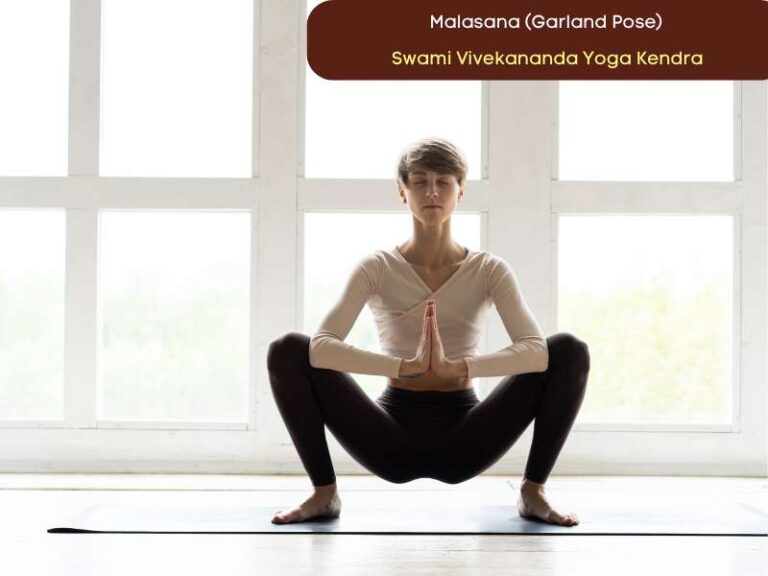Welcome to Swami Vivekananda Yoga Kendra! Today, let’s take a deep dive into Malasana (Garland Pose), a simple yet incredibly effective yoga pose that helps improve flexibility, strengthens the lower body, and supports digestion. Whether you’re new to yoga or a seasoned practitioner, this pose can work wonders for your overall well-being.
Malasana (Garland Pose) – A Simple Yet Powerful Yoga Pose
Hey there, yoga enthusiast! Have you ever noticed how naturally babies squat while playing? That deep, relaxed squat is actually one of the most natural and beneficial positions for the human body. In yoga, we call it Malasana (Garland Pose)—a simple yet powerful posture that stretches the hips, strengthens the lower body, and even supports digestion.
Whether you’re looking to improve flexibility, ease lower back tension, or just want a grounding pose to calm your mind, Malasana has got you covered. The best part? It’s beginner-friendly and can be modified to suit all levels. So, let’s dive in and explore how this ancient yogic squat can benefit your body and mind!
How to Do Malasana (Garland Pose) – Step-by-Step Guide
Start in a Comfortable Standing Position: Stand with your feet slightly wider than hip-width apart. Let your toes naturally point outward to make the squat easier.
Lower into a Deep Squat: Slowly bend your knees and drop your hips down toward the ground. Try to keep your heels flat on the floor, but if they lift, that’s okay—just place a cushion or rolled-up towel under them for support.
Join Your Hands in Prayer Position: Bring your palms together at your heart center in Anjali Mudra (prayer pose).
Use Your Elbows for Support: Gently press your elbows against the inner sides of your knees. This will help open up your hips and deepen the stretch.
Keep Your Back Straight: Engage your core, lift your chest, and lengthen your spine to avoid slouching.
Focus on Your Breath: Inhale deeply, feeling your body expand. Exhale slowly, allowing yourself to settle into the pose. Stay here for at least 30 seconds to a minute.
Come Out of the Pose Mindfully: When you’re ready, gently straighten your legs and return to a standing position.
Why You Should Practice Malasana (Garland Pose) – Key Benefits
Boosts Hip Flexibility: Malasana is an excellent pose to stretch and open up the hips, groin, and lower back. It promotes better mobility, making everyday activities like walking, running, and sitting more comfortable and fluid.
Strengthens the Lower Body: By engaging the thighs, calves, and core muscles, this pose helps build endurance and stability. Over time, it strengthens the legs and improves overall body balance, reducing the risk of injuries.
Aids Digestion Naturally: This pose encourages better circulation to the abdominal organs, stimulating digestion and helping with issues like bloating, constipation, and sluggish metabolism. It’s a natural way to support gut health.
Improves Posture and Balance: By keeping your spine upright and activating your core, Malasana helps develop body awareness. It encourages good posture, reducing strain on the lower back and improving overall stability in daily movements.
Eases Lower Back Tension: If you experience lower back discomfort, Malasana can help relieve tension by stretching and strengthening the muscles around the spine. Regular practice can lead to improved spinal alignment and reduced stiffness.
Why You Should Try Malasana (Garland Pose)
If you’re looking for a simple but powerful yoga pose to increase flexibility, strengthen your lower body, and support digestion, Malasana is a great addition to your practice. It’s easy to do, yet the benefits go far beyond just stretching—this pose helps you feel more balanced, both physically and mentally.
Join Us for More Yoga Guidance!
Want to experience the benefits of Malasana firsthand? Join us at Swami Vivekananda Yoga Kendra, where our expert instructors will guide you through yoga sessions designed to enhance flexibility, balance, and inner peace. Let’s practice together and embark on a journey of wellness!
1. Can beginners do Malasana?
Absolutely! If you find it difficult to squat fully, try placing a block or cushion under your heels for extra support.
2. How long should I hold the pose?
Start with 30 seconds and work your way up to a minute or more as your flexibility improves.
3. Does Malasana help with digestion?
Yes! The deep squat position stimulates your digestive organs, making it great for gut health.
4. What if my heels don’t touch the ground?
No worries! You can place a rolled-up towel or a yoga block under your heels to make the pose more comfortable.
5. Can Malasana relieve lower back pain?
Definitely! By stretching the lower back and engaging your core, this pose can help release built-up tension and improve spinal alignment.
Transform Your Life with us: Join Our Online Classes Now:
Ready to dive into a world of wellness? Come join us for some online meditation classes to find your inner calm, hop into our online yoga classes to take your practice up a notch, or why not even become a certified yoga teacher? Embrace the power of yoga today and let it lead you to a happier, healthier you!




Comments are closed.